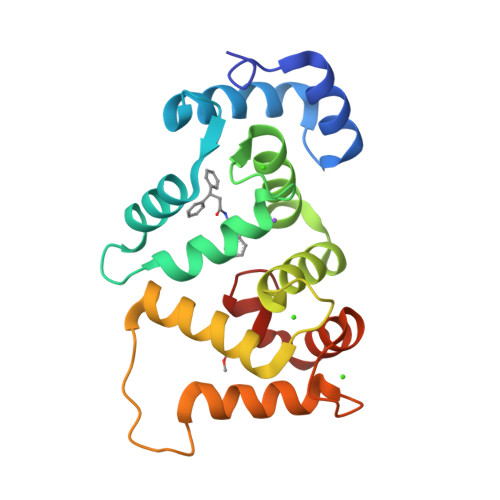Deciphering the Inhibition of the Neuronal Calcium Sensor 1 and the Guanine Exchange Factor Ric8a with a Small Phenothiazine Molecule for the Rational Generation of Therapeutic Synapse Function Regulators.
Roca, C., Martinez-Gonzalez, L., Daniel-Mozo, M., Sastre, J., Infantes, L., Mansilla, A., Chaves-Sanjuan, A., Gonzalez-Rubio, J.M., Gil, C., Canada, F.J., Martinez, A., Sanchez-Barrena, M.J., Campillo, N.E.(2018) J Med Chem 61: 5910-5921
- PubMed: 29966094
- DOI: https://doi.org/10.1021/acs.jmedchem.8b00088
- Primary Citation of Related Structures:
6EPA - PubMed Abstract:
Protein-protein interactions (PPIs) are known to play an essential role between the neuronal calcium sensor 1 (NCS-1) and the guanine exchange factor Ric8a to regulate synapse function, emerging as a druggable interface for synaptopathies such as the fragile X syndrome (FXS). Recently, the phenothiazine FD44 has been identified as an inhibitor of this PPI, decreasing the abnormally high synapse number and enhancing associative learning in a FXS animal model. Here, we have integrated advanced experimental and computational studies to obtain important structural insights into Drosophila NCS-1/FD44 recognition to understand the basis of its affinity and specificity and generate improved PPI regulators. This has allowed the identification of a new small drug-like molecule, IGS-1.76, which efficiently inhibits the human NCS-1/Ric8a complex with improved binding potency. The crystal structure of the Drosophila NCS-1/IGS-1.76 complex demonstrates that the new inhibitor, although chemically different from FD44, shares the same mechanism of action and constitutes a new hit candidate for FXS.
- Centro de Investigaciones Biológicas-CSIC , Ramiro de Maeztu 9 , 28040 Madrid , Spain.
Organizational Affiliation:






















